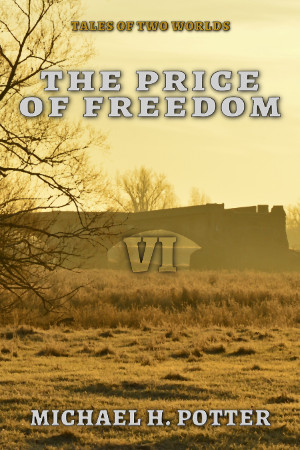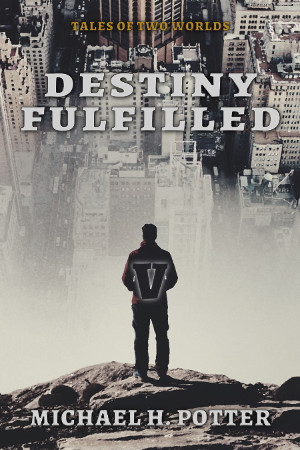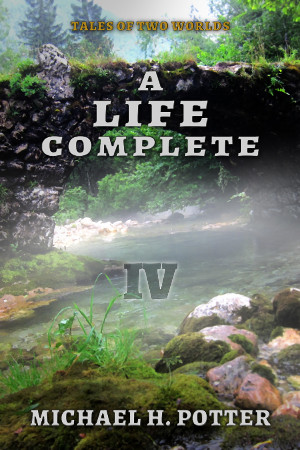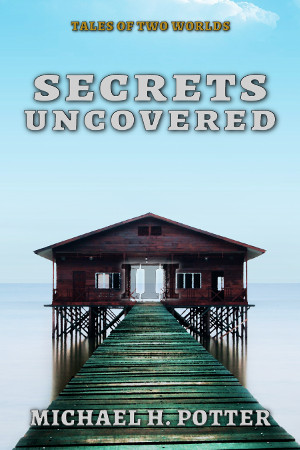I first started writing my Otherworld series in 2013. Nine years is an awfully long time no matter how you look at it, and it’s the longest I’ve stuck with…well, pretty much anything in my life. Okay, my laptop dates to 2007, my tablet is from 2011, and I still play retro games from the 80s, but you get the idea. Otherworld is my longest-lived creative pursuit by far.
The setting still has a lot of life, even if I’m not sure I do. I’d originally planned four “seasons” of eight stories each, for a total of 32 “episodes” in the series. Later on, as I discovered that some stories needed to be told outside that fixed schedule, I added a kind of interstitial set, which I (quite naturally) called A Bridge Between Worlds. That six-part miniseries then became a blueprint: the time between Seasons 2 and 3 got its own bridge stories, Tales of Two Worlds, and I intended to write a third group, titled Best of Both Worlds, before tackling Season 4. Will that still happen? I don’t know. I’d like to keep it going, though.
Now, while I set out with the idea of writing eight short novels that functioned as individual parts making up a cohesive whole, Otherworld originally served two purposes that had nothing to do with creating a million-word magnum opus. First, it was a playground for worldbuilding, because that, to me, is one of the most enjoyable aspects of fiction creation. More specifically, this series was to be my experiment in creating languages as something more than a one-off, and with the intention of somehow using them.
That succeeded, in my opinion. In its 33 entries so far (20 episodes, 12 bridge stories, and a prequel/spinoff) I’ve managed to sneak in snippets from seven of the ten languages I sketched out for the setting. Most of the time, it’s a single word or phrase here and there—most of the characters in narration are people from Earth who have been transported to the Otherworld setting, and that’s one way I represent their lack of knowledge about that world. A couple of times, I’ve included longer stretches of alien speech, usually to indicate a change in style or formality, or to show that a piece of text is in a language nobody understands. It’s not perfect, but then Otherworld is a labor of love. I’ve never truly expected anyone to read it.
As I wrote, the languages and even the setting itself began to shift into the background. Somehow, despite all my intentions to the contrary, I began writing a character-based drama. Some episodes even end up as more “slice of life” than anything, and that’s a genre I never even wanted to enter.
But it worked out that way, and I feel that’s partially due to the characters I chose at the beginning. They numbered seven, all in their early 20s, all college students. Nothing like someone who had just turned 30 and never even set foot on a college campus as an adult, right?
Apart from that minor distinction, these seven were…parts of me. Through the nine years of Otherworld, I’ve come to understand that. They represent aspects of my personality, whether or not I realized it in the beginning. I grow, and so do they, but in different ways. And that’s what I want to look at today. Where were they at the start? Where are they now? And what does that say about me?
Obviously, this post is spoiler-heavy, and it even includes spoilers for stories that aren’t out yet. Then again, Otherworld isn’t the kind of story where knowing what happens next ruins the ending. It’s about the journey, not the destination.
We’ll start with Ryan. After all, he’s the leader. Initially, I saw him as just that, maybe with a little bit of jock mixed in. To put it bluntly, Ryan is the avatar of my masculinity. He’s a man, he knows it, and he knows what it means. So he has a chivalrous streak, not because he thinks women are weaker than men, but because he has the protective nature that I believe all men should strive for.
After two and a half years of story time, Ryan has become a CEO. I’m a CTO, so that’s not completely out of the realm of possibility. He’s still the protector, though, the man who places himself in charge to make sure nobody else gets hurt in his place. And he has been hurt: physically, by being on top of a collapsing wall in Situational Awareness, and the mental strain of dealing with a natural disaster in Waters Rising.
He hasn’t come out unscathed. Neither have I, even if most of my wounds are self-inflicted. But we’ll get to that in a moment.
Before I even typed the first word of what became Out of the Past, I knew Jenn would be the hardest to characterize. She’s so unlike me that I’ve written two posts complaining about the troubles I had finding her voice. I still haven’t fully grasped it after all these years, and I continue to find her chapters a chore, but I’m finally starting to come to terms with her.
Jenn is the explorer in me. That’s the best way I can describe it. She always wants to see what’s around the next bend or over the next hill, and she won’t stop until she finds a way to get there. But she has something I don’t, something I often wish I did. In The City and the Hill, she felt compelled to hide her faith. By Light to the Depths, she has embraced it, and found her calling as a kind of missionary.
I’ll never be one to spread Christianity to anyone, let alone a bunch of medieval-level demihumans living on another planet. Strange as it seems, though, I do see that same kind of zeal buried deep within myself. It’s one of the reasons I’m working on the technetism project, and I have to admit that Jenn earns some measure of credit for bringing that out.
Amy got the first chapter of Out of the Past and the last non-epilogue scene of Long Road’s End. There’s a good reason for that, and it’s the core of what makes her character. She is my hope, my optimism. She always has been. Since I wanted to start off on the right foot, the opening scenes of the series are from her point of view: a young woman seeing parts of the world for the first time and wondering what might be out there. By the end of Season 1—a mere four months, really—she has lived a life, and now she’s excited to come home and tell people all about it…but equally ready to go back.
More than any other character, Amy fell in love with the Otherworld, just as I did. She spent the entirety of The Control Variable thinking about what would happen the next time she had a chance to go there. When she finally did in The Second Crossing, she threw herself into it. Now, she’s happily married (beating me in both categories) and living the dream. But she still wants to make things better for herself and everyone around her. She has a love of the world around her, but also faith in humanity.
That’s me in a nutshell. Even underneath all the depression and anxiety that have troubled me for the past two years, I still retain both of those. Since I so rarely have the chance to let them out, Amy becomes my outlet. Through her words and actions, I can express my feelings.
That’s becoming increasingly true of Ashley, as well. At the start, she was even more the devil’s advocate character than Jenn. I detest identity politics and “wokeness” in all their myriad forms, and 2013 was around the time I started noticing such evils creeping into society. Since Otherworld was set a few years later, my thought was that the rot would only increase—I was right, but I’ll save the gloating for another post—and it just made sense that at least one of the characters would be all-in on the whole thing.
She’s grown a lot since then. In Situational Awareness, she came out as bisexual. (I’m certainly not doing that, so don’t get any ideas!) The stories of A Bridge Between Worlds introduced the character of Jeanette, who has since become somewhat more than a love interest; Light to the Depths involved the two of them dealing with a near-breakup, then committing to taking their relationship to the next level. I’d like nothing more than to have that chance.
While she still retains some of her former beliefs, they’ve been tempered by time in the Otherworld. She learned, which is something so many people her age just can’t do today. If Ashley represents any part of me, then, it’s the willingness to try something, to dive into a new hobby or job or, well, relationship. Yes, that can get me into trouble, but it’s fun while it lasts, right?
At first glance, Lee is even harder to pin down. I think that comes from being a little bit of a mixture. On one hand, he is my connection to history and heritage: he’s proud of his Navajo ancestry, just as I am of my descent from Cherokee and Choctaw ancestors. On the other hand, he also carries some of my sense of humor. He’s acerbic, sarcastic, often to the point of grating, and that makes him easy to write half the time.
His character growth has been the most obvious of all. Lee’s chapter in A Matter Settled was, at the time, the closest thing to a sex scene that I’d ever written. His scenes in Written in Black and White, where he became the first Earthling to marry a woman native to the Otherworld, were an adventure for me as much as him. The Code Breaker saw him become a father and invent a whole new trade, two items high on my own bucket list.
Lee’s history resembles mine in another way, however. His parents divorced when he was 11, and he grew very attached to his mother as a result. Not in any Oedipus kind of way, mind you, but the very natural clinging of a desperate, depressed child to the only anchor in his life. My own life, with a similar event at almost the same point, comes to mind when I read the family reunion in The Second Crossing, and it’s one of the few Otherworld scenes that brings me close to tears.
Jeff also stayed behind in Long Road’s End, choosing the relative unknown of the Otherworld over a return to everything he’d ever known on Earth. Like Lee, he did it because of a woman, even if he claimed otherwise.
But let’s back up for a moment, because Jeff has another purpose in the story. He was always the linguist, and thus the best way for me to introduce the language aspects of the setting. To do that, however, I had to make him knowledgable. Thus, Jeff is the avatar of knowledge, and he has stayed as such throughout the entire nine years of writing. His scenes are my window into the greater history of the Otherworld, which has even led to Seasons Change, the prequel set over four thousand years before the main story. Without Jeff, I never would’ve considered doing that.
On top of all that, he has to be the teacher within the setting, too. Part of that comes from my innate desire to teach, because what good is knowledge if you keep it all to yourself? His native wife is certainly very indulgent in many respects, but her occasional chapters have given me the chance to illustrate that from another point of view: one of the biggest reasons she loves Jeff is because of the way he opened her eyes to a whole new way of looking at the world. Almost nothing would make me happier than a woman saying the same about me.
Last, but certainly not least, is Alex. I saved him for the end because anyone who has read Otherworld (or even my earlier posts about it) knows that Alex is simply me. He’s a genius whose favorite subjects are math and astronomy. He’s an overweight loner with major depression and a serious lack of self-esteem. He’s a guy who’s terrible at relationships and somehow finds himself falling into one. He is the author insert, and I won’t deny that.
Yet Alex still shows character growth. In that, he has become a kind of yardstick. He does the things I want to do, and I measure my success against what I’ve written for him. Ever since Situational Awareness, so much of his character arc has been about his flailing about in matters of love; while I never expected I’d have the chance to experience that when I wrote the story in 2016, that’s pretty much what happened. I’m sad to report that Alex handled it much better than I could.
Over the course of 32 stories and a million-plus words, he has reinvented himself. Sure, he lapses into “loner geek” mode on occasion, but at least he can get out of it. Although he continues to worry about how others see him, judging himself as he believes they would, he understands that his life has become better. For me, that would be the marker of true success: not only improving my lot, but recognizing and accepting that it has improved. As this new year dawns, and the first decade of Otherworld is nearing its end, I still can’t do that, so Alex remains a vision of what my life could be, what I would like it to be.
These seven aren’t the only perspectives in Otherworld, but they are the ones who received the most time on screen and the most dedication in my writing. For one such as me, seemingly destined to be alone and childless, they are my friends, my children. Because they, more than any other characters I’ve written, are pieces of me. They always will be. As Otherworld enters its tenth year, I see that more clearly than ever.






